In early 2023, Iran faced the greatest array of challenges since the early days of the revolution. At home, the unpopular government was dealing with enduring protests, soaring inflation, and energy shortages. Abroad, Iran was increasingly isolated over its human rights record, controversial nuclear program and support for Russia’s war in Ukraine.
The death of Mahsa Amini ― a 22-year-old Kurdish woman detained in September for improper dress ― sparked widespread protests that led to a harsh government crackdown. The regime “is more isolated now than it's been in a very long time,” Robert Malley, the U.S. Special Envoy for Iran, said on November 30. “And that's because we, together with many others, have made sure that the truth of what's happening in Iran is visible for all to see.”
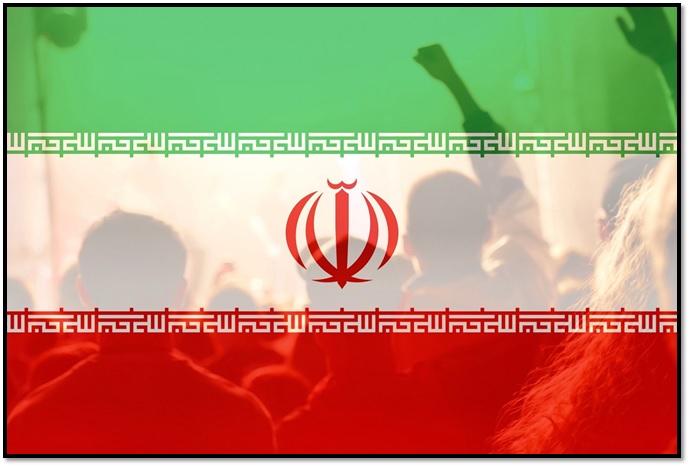 At the beginning of 2023, the government of President Ebrahim Raisi appeared unwilling or unable to deal with the confluence of political, social and economic challenges. Many senior officials lacked relevant executive or managerial experience when they took office. Raisi, a hardline cleric elected in 2021, had a primarily religious education and spent most of his career in the judiciary. His all-male cabinet included few experienced technocrats. Out of his 19 cabinet-level positions, four were members of the Revolutionary Guards.
At the beginning of 2023, the government of President Ebrahim Raisi appeared unwilling or unable to deal with the confluence of political, social and economic challenges. Many senior officials lacked relevant executive or managerial experience when they took office. Raisi, a hardline cleric elected in 2021, had a primarily religious education and spent most of his career in the judiciary. His all-male cabinet included few experienced technocrats. Out of his 19 cabinet-level positions, four were members of the Revolutionary Guards.
In 1979, Iran’s revolutionaries wanted to replace the monarchy with a utopian state based on three key principles: independence (istiqlal), freedom (azadi) and Islamic Republic (Jomhouri-e Eslami). Four decades later, Iran was falling short on all three.
On independence, Iran in early 2023 was increasingly dependent on China, its biggest oil customer, and Russia, an important military partner. For years, the government has promoted the “resistance economy” model of self-reliance. But between March and November 2022, Iran ran a trade deficit of nearly $5 billion (excluding oil goods). Iran also had yet to attain food self-sufficiency, a goal enshrined in the constitution of 1979.
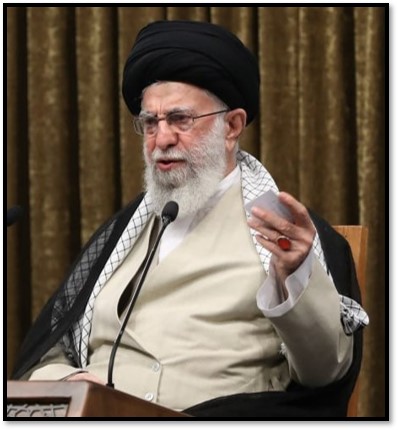
On freedom, Iran restricted both personal and political rights. For decades, security, judicial and political officials have carried out extrajudicial killings, conducted torture, detained citizens arbitrarily, restricted free expression and religious freedom, and discriminated against women and minority groups, among other offenses. In Freedom House’s 2022 report, Iran received a dismal score of 14 out of 100, with 100 being the most free.
On the concept of Islamic Republic, Iran narrowed the political space by pushing reformists and moderate conservatives out of electoral politics. By paving the way for hardliner dominance, the state delegitimized the parts of the government that were intended to be representative of the will of the people.
Both the executive and legislative branches lacked a broad public mandate to address the challenges of 2023. The Guardian Council, a 12-man panel of jurists, barred the vast majority of candidates, especially reformists and centrists, in the previous two elections. Raisi won the 2021 presidential election with 62 percent of the vote, but the turnout was just 48.8 percent, the lowest in the history of the Islamic Republic. Similarly, in the 2020 parliamentary election, the turnout was only 42.6 percent, the lowest since the 1979 revolution.
Protests and Crackdown
In 2023, Iran faced more political unrest. Protests broke out on Sept. 16, 2022, after the death of Mahsa Amini. Demonstrators initially called for more personal freedoms but quickly started demanding the ouster of Supreme Leader Ayatollah Ali Khamenei – who has been in power since 1989 – and the end of the Islamic Republic. Within two weeks, the protests spread to all 31 provinces.
Protests have broken out periodically in the past five years. The 2017-2018 protests were over the high price of basic goods, such as eggs. The 2019 demonstrations were triggered by an overnight gasoline price hike. In early 2022, soaring bread prices and other staples brought people into the streets. But those rounds of demonstrations only lasted a few weeks at most.
The 2022-2023 protests have endured for more than four months despite the government crackdown. As of January 2, at least 19,000 people had been detained and more than 500 had been killed, according to human rights groups. Two were executed and dozens more face the death penalty. The resilience of the demonstrations reflects widespread disillusionment with the government, but the protesters lacked leadership and a unifying set of specific goals.
The protests “posed the greatest challenge to political stability since the 1979 revolution,” according to Hadi Semati, an analyst and former Tehran University professor. “But the turnouts did not mobilize large enough crowds or diverse enough sectors of society to pose an imminent danger to the regime.”
Even though the three branches of government – the presidency, parliament and the judiciary – were dominated by hardliners, the government did not have a unified approach for dealing with the unrest. In 2022, the security forces often used non-lethal means, including tear gas and rubber bullets, to disperse crowds in what appeared to be an effort to minimize deaths and avoid adding fuel to the fire.
Some officials called for harsher punishments for demonstrators, while others urged dialogue or counseled reform. “I hope security will be completely restored in the country soon,” Parliamentary Speaker Mohammad Bagher Ghalibaf said in November, “so that legitimate and necessary changes would begin to establish a new governance in economic, social and political areas within the framework of the Islamic Republic.” In January, he said that he was trying to build consensus among officials on a “renovation” of the system, focusing on economic issues, but did not offer details.
Iran was largely isolated over its human rights record, including its treatment of demonstrators. In 2022, Western countries imposed sanctions on dozens of officials and organizations tied to the crackdown. In November, the U.N. Human Rights Council voted to create a fact-finding investigation into the bloody crackdown on protesters. The evidence collected could be used in future prosecutions of Iranian officials in international courts. In December, the U.N. Economic and Social Council removed Iran from the Commission on the Status of Women. No country had ever been ousted from the panel before. The move was largely symbolic but reflected growing international outcry.
Economic Crisis
At the start of 2023, the economic outlook was gloomy. Without a revival of the nuclear deal and the accompanying relief from U.S. sanctions, Iran was on track for meager growth, largely dependent on oil sales. The government did not appear to have a viable strategy for curbing inflation, which was hovering near 50 percent. Between March and June 2022 alone, $10 billion was sent abroad, according to the Central Bank of Iran. “Without prospects for improvement, businesses and investors will likely continue to cut back on investment that the economy needs, and capital and people will continue to leave Iran,” according to Henry Rome, a senior fellow at the Washington Institute for Near East Policy.
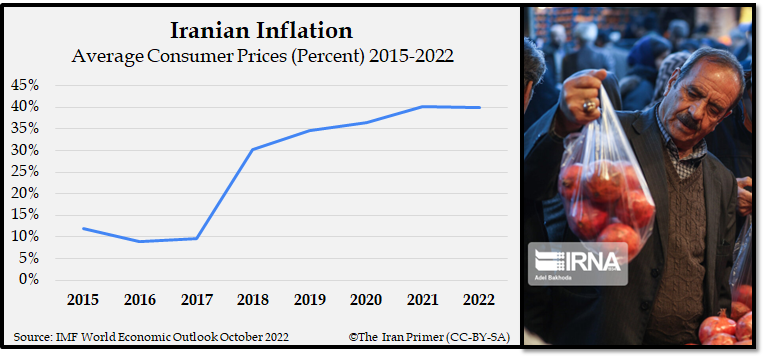
High inflation: Consumer prices near the end of 2022 were up 48.5 percent compared to a year earlier, according to the Statistical Center of Iran. Food and beverage prices were up more than 60 percent.
Weak GDP growth: In October, the International Monetary Fund forecast that the economy would grow 3 percent in 2022/23, down from 4.7 percent in 2021.
Plummeting currency: On Dec. 28, 2022, the rial hit an all-time low against the dollar. It took 440,00 rials to buy one dollar.
High unemployment: In October, the IMF forecast an unemployment rate of 9.4 percent for 2022/23.
Energy shortages: Iran was struggling to meet domestic demand for energy. Iran has the world’s second-largest natural gas reserves, but a rise in consumption overtook the increase in production by 35 million cubic meters per day in 2022. Iran planned to buy Russian gas to make up for the shortfall. Amid dropping temperatures, demand spiked in late 2022, which led the government to cut off gas to more than 800 government and public organizations and agencies. The government encouraged businesses and citizens to reduce consumption.
Domestic demand for gasoline also surged in 2022. If consumption is not curbed, Iran will need to resume imports of gasoline, the head of the Iranian Union of Oil, Gas and Petrochemical Exporters warned in December. Iran, which has the world’s third-largest oil reserves, had become a gasoline exporter in 2019.
Stalemate in Nuclear Diplomacy
In 2023, prospects for reviving the 2015 nuclear deal, known as the Joint Comprehensive Plan of Action (JCPOA), were slim. The world’s six major powers began new negotiations – coordinated by the European Union – with Iran in April 2021. But after several rounds of off-and-on talks, no breakthrough was forthcoming.
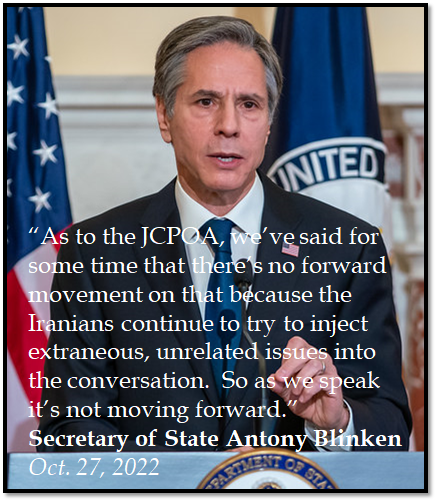 In August 2022, Iran failed to agree to the terms in a “final” draft of a deal presented by the European Union. The United States blamed Iran for making extraneous demands in the talks. “As long as they continue to do that, there is no possibility, no prospect for an agreement,” Secretary of State Antony Blinken said on October 21. U.S. officials said that they were focused on the protests and Iran’s military support to Russia instead.
In August 2022, Iran failed to agree to the terms in a “final” draft of a deal presented by the European Union. The United States blamed Iran for making extraneous demands in the talks. “As long as they continue to do that, there is no possibility, no prospect for an agreement,” Secretary of State Antony Blinken said on October 21. U.S. officials said that they were focused on the protests and Iran’s military support to Russia instead.
On the sidelines of an election rally on November 3, a woman asked President Biden to announce that the JCPOA was dead. He initially responded “No,” but then added, “It is dead, but we are not going to announce it.” Neither side wanted to declare that diplomacy had failed.
At the end of 2022, Iran was losing patience with the United States and the Europeans. “The window for reaching an agreement on the part of the Islamic Republic of Iran will not always be open,” Foreign Minister Hossein Amir-Abdollahian warned on December 28. “If the Westerners want to continue their hypocritical and interventionist behavior, we will move in the direction of another plan.” He did not elaborate. Without relief from U.S. sanctions, however, Iran’s economy will remain shackled in 2023.
As diplomacy stalled, tensions mounted as Iran ramped up uranium enrichment and installed more advanced centrifuges, cylindrical machines that enrich uranium.
Under the deal, Iran was limited to enriching uranium to only 3.67 percent – far below 90 percent purity, which is considered weapons-grade. By the end of 2022, Iran, however, had sizable stockpiles of uranium enriched to 20 percent and 60 percent. Iran was closer to the nuclear threshold than ever before. “As of 2022, no other nation without a nuclear weapon was enriching to 60 percent,” noted Kelsey Davenport, Director for Nonproliferation Policy at the Arms Control Association.
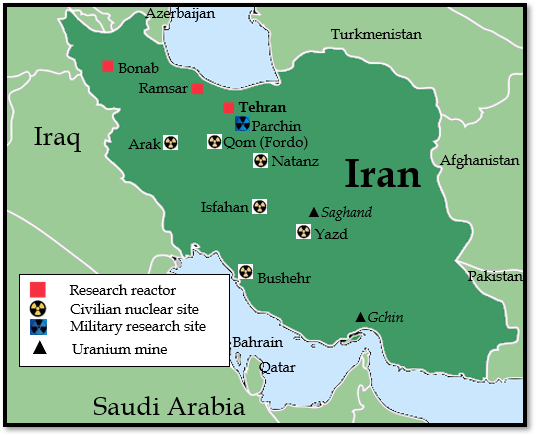 The JCPOA had also limited Iran to enriching uranium with IR-1 centrifuges, early models developed in the 1990s. In 2022, Iran, however, more than doubled the number of installed IR-2 centrifuges, more advanced models. “The IR-2 is about three to four times as efficient as the IR-1,” Davenport explained. “Iran also more than tripled the number of installed IR-6 centrifuges, which can be up to six times more efficient than the IR-1.”
The JCPOA had also limited Iran to enriching uranium with IR-1 centrifuges, early models developed in the 1990s. In 2022, Iran, however, more than doubled the number of installed IR-2 centrifuges, more advanced models. “The IR-2 is about three to four times as efficient as the IR-1,” Davenport explained. “Iran also more than tripled the number of installed IR-6 centrifuges, which can be up to six times more efficient than the IR-1.”
Some of Iran’s moves also called its intentions into question. For example, in November 2022, Iran started enriching uranium to 60 percent at the Fordo nuclear site. “This step, which carries significant proliferation-related risks, has no credible civilian justification,” Britain, France and Germany said. Iran had already been enriching uranium to 60 percent at the above ground site at Natanz. Enriching to such a high level at Fordo was more troubling because it was buried deep under the mountains near Qom at a facility difficult to destroy in a military strike.
Iran’s advances cut its breakout time – the time needed to enrich enough uranium to make one nuclear bomb – to less than a week. When Iran was fully complying with the JCPOA’s restrictions, the breakout time was about 12 months. If Iran made the political decision to produce a bomb, it would need to take several more steps – including converting the uranium gas to a metal, encasing the metal with conventional explosives, fitting the metal into a warhead, and marrying the warhead to a delivery system, such as a ballistic missile. The weaponization process could take two years, according to arms experts and Israeli officials. But those steps could be taken at small, covert sites that would be hard to detect.
U.N. Nuclear Watchdog Probe
In 2023, Iran could face additional pressure from the U.N. nuclear watchdog’s Board of Governors to explain uranium traces at three undeclared sites. The locations were linked to work done before 2003, when Iran had a nuclear weapons program. The investigation was opened in 2018, but Tehran stonewalled the International Atomic Energy Agency (IAEA). Iran, one of the 62 original signatories to the Nonproliferation Treaty in 1970, is required to account for its nuclear materials regardless of the status of the JCPOA.
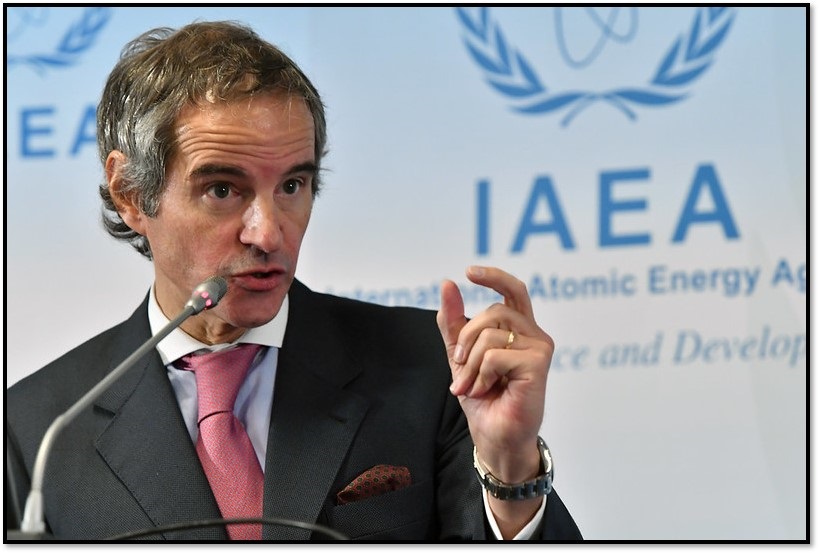
In 2022, the board of the International Atomic Energy Agency (IAEA), passed two resolutions urging Iran to provide credible explanations for the uranium traces. Both stopped short of referring the case to the U.N. Security Council for debate or potential action. But the United States, in a separate statement in November, warned that the Board of Governors “will have to be prepared to take further action, including under Article XII.C of the Agency’s Statute,” which includes referral to the Security Council. The IAEA lacks enforcement mechanisms, but the Security Council could impose new international sanctions.
Support for Russia’s War
In 2023, Iran could face additional Western sanctions and isolation for providing arms to Russia. Iran’s decision to aid Russia in the war on Ukraine reflected the deepening strategic alliance with Moscow. Iran provided hundreds of drones—including the Shahed-136 suicide drone and the Mohajer-6 reconnaissance and strike drone—and sent trainers to Russia and Crimea in 2022. “They're now also helping Russia kill innocent Ukrainian civilians,” U.S. Special Envoy for Iran Malley said in October. “Iran has made a very bad bet. You're seeing calls from across the globe saying this is simply outrageous,” he added.
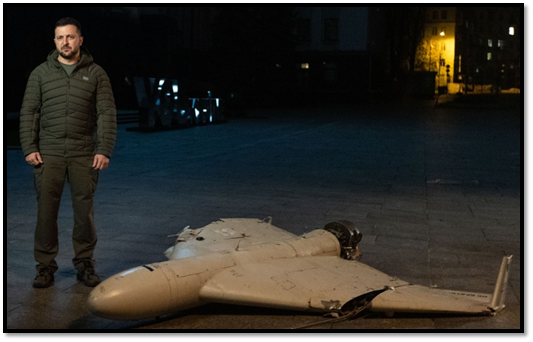
The United States, Britain, France, and Germany urged the United Nations to investigate the origin of the drones used by Russia. The United States, the European Union and Britain also sanctioned Iranian officials and companies for supplying drones to Russia. In late 2022, U.S. officials and a U.N. diplomat warned that Tehran may sell surface-to-surface missiles and more drones to Moscow. Iran has become Russia’s “top military backer,” John Kirby of the U.S. National Security Council revealed on December 9.
Garrett Nada, managing editor of The Iran Primer, assembled this report.
